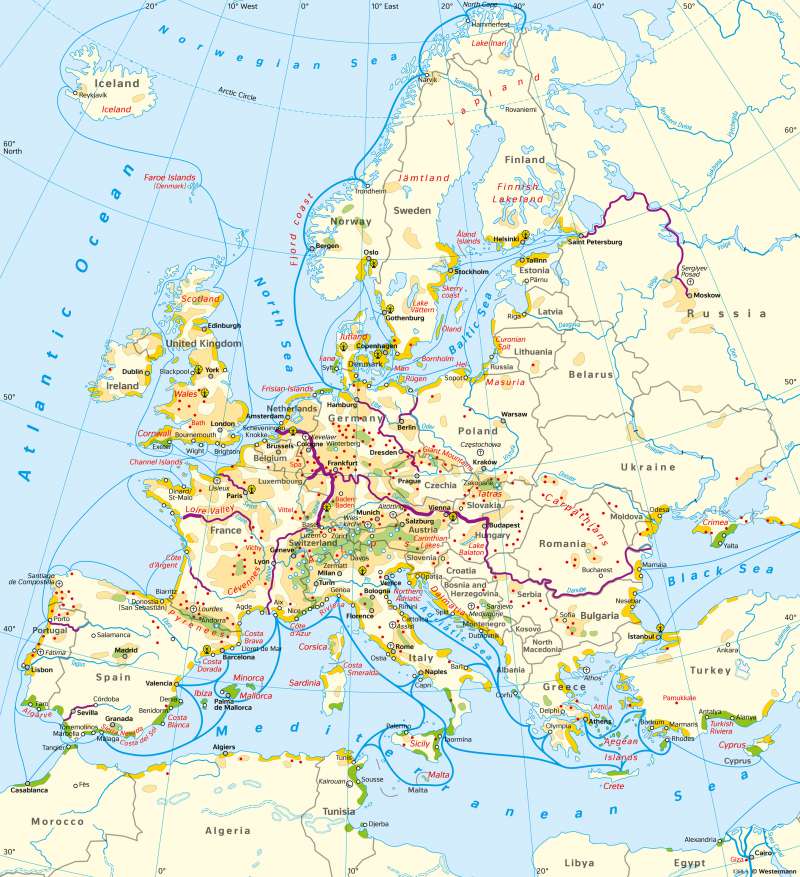Europe - Tourism
Tourism
978-3-14-100890-6 | Page 71 | Ill. 3

Overview
Destinations for tourism in Europe are primarily the coasts, especially those of the Mediterranean countries and islands. Important factors there are the Sunny climate, the beaches, scenically varied coasts, good accessibility, and the developed infrastructure. Other popular tourist spots are the mountains and some large cities, some of which are among the most visited tourist destinations in the world.
Spatials structures of European tourist destinations
The first seaside tourism resorts were established from the mid-18th century on the French and Italian Rivieras and in Istria. Until the First World War, the Gulf of Naples with Capri and Ischia also developed into a tourist region for the upper class. The development into mass tourism was made possible by factors such as higher incomes, a greater number of days off work, the motorisation of broad sections of the population and the expansion of the transport infrastructure. From the mid-1950s, the move to the "sunny south" began on a broad basis. Destinations were primarily the beaches on the Mediterranean coast, such as those on the Italian Adriatic. More distant destinations such as the Costa del Sol or Sicily were only opened up to tourism with the expansion of air travel.
From the 1960s and 1970s, the French and Spanish Mediterranean coasts, the Balearic Islands, the Algarve, and the Tunisian coast also became tourist destinations. From the 1980s, the Turkish Mediterranean coast, mainly around Antalya, and the Moroccan Atlantic coast followed.
Today, the first-generation tourist infrastructure is being replaced or fundamentally modernised in many places to meet changing needs. In Morocco, tourism is still an important economic sector, whereas in Tunisia it reached a peak around 2010, but then, similar to Egypt, experienced a severe slump due to domestic unrest and Islamist terrorist attacks, from which it has not yet fully recovered.
The mountains serve summer and winter recreation to varying degrees. For winter sports, sufficient snow guarantee, easy accessibility, and a corresponding infrastructure - for example in the form of ski lifts, levelled ski slopes, snow cannons - are necessary prerequisites.
By far the most important destination of this kind is the Alps. Especially winter tourism is often more pronounced than summer tourism, and in certain regions, for example in Tyrol (outside the Inn Valley), it even is most important part of the economy. Less important destinations for winter tourism are located in the Scandinavian mountains, the Giant Mountains and the High Tatras, the Pyrenees, the Sierra Nevada, the Dinaric Mountains and the Rhodope Mountains.
In summer, the mountains in the Mediterranean region are traditionally used as summer resorts to escape the intense heat in the lowlands (for example Abruzzo near Rome, Cevennes in southern France, Sierra de Guadarrama near Madrid). There is also summer tourism in the mountains in Western, Central and Northern Europe. In particular, the low mountain ranges and their valleys are favoured by hikers and bicycle tourists.
Pilgrimage tourism is one of the oldest forms of travel. Pilgrimage and pilgrimage sites are found in European countries with predominantly Catholic and Greek Orthodox populations.
The location of spas and health resorts often follows geological guidelines such as fault zones and faults. In areas of former volcanic activity such as the French Massif Central, a concentration of spas can also be identified. A favourable bioclimate, such as stimulating strength or particularly pure air, can also determine the choice of location here.
City trips are one of the strongest market segments in tourism - not least because of low-cost airlines. In city tourism, short trips with a maximum of four nights predominate. Attractions are historical sites and monuments, cultural centres, but also shopping and entertainment opportunities. In addition, there is a trend towards "event tourism", where temporary major events, for example European or World Football Championships, art exhibitions or music weeks, are very attractive. City tourism also includes professionally motivated business, trade fair and congress travel. Overall, the major cities show the least seasonal fluctuations and the highest visitor numbers.
Other growth segments in recent years have been cruises of one to two weeks and short stays in theme parks and wellness hotels. The coastal cities of the northern Mediterranean are visited by numerous cruise ships. A relatively new market segment is club cruises, targeting younger travelers. Nordic cruises during the summer have been popular since the beginning of the 20th century because of the special landscape experiences, the midnight sun and the northern lights. From May to September, the coastal cities on the Baltic Sea are a popular cruise destination. River cruises focus on the river valleys that have been developed for tourism since the Romantic period, first and foremost the Rhine. The Upper Middle Rhine Valley between Bingen and Koblenz, which is heavily frequented by excursion ships, is particularly noteworthy. Other popular rivers are the Danube, the Moselle, the Rhône and the Volga.
Popular leisure and adventure parks are almost always located near urban centres and are well connected by transport. They traditionally target day tourism, but with integrated theme hotels or attached bungalow parks they are becoming increasingly important destinations for short breaks, which are competing with the classic family annual holiday. The leader in Europe is Disneyland near Paris.
The Corona Pandemic 2020 has brought tourism in Europe and globally to an almost complete standstill, or at least changed it significantly. As the chart on the bottom right shows, reservations abruptly declined when the pandemic hit the world because of travel bans and for safety reasons. In 2021, some countries are slowly starting to open up again, but the trend goes towards domestic travel or trips to neighbouring countries, as opposed to long-distance travel. Whether this development will have lasting effects after the probable containment of Covid-19 is currently not foreseeable.




